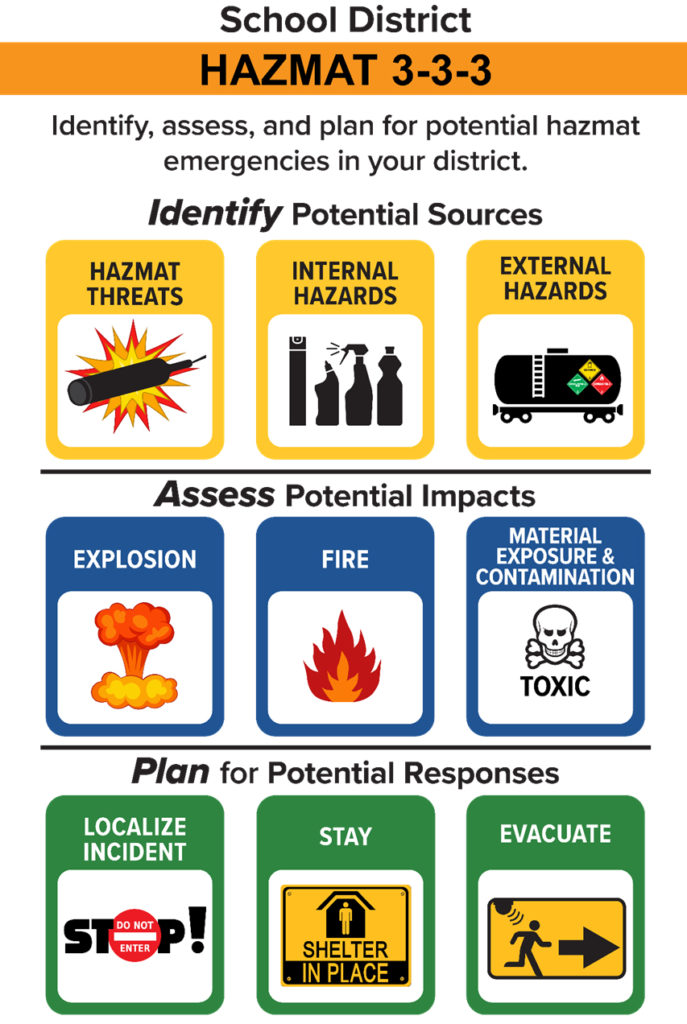
TTI recently developed a Hazardous Materials and Train Derailment Emergency Planning Guide for School Districts and Community Colleges to help school district administrators, emergency managers, and safety officers plan for hazmat incident and train derailment emergencies. Hazardous materials are transported through almost every Texas community every day—by road, rail, pipeline, waterways, or air. Places where hazardous materials are used, stored, or made include warehouses, fuel stations and terminals, agricultural cooperatives, refineries and chemical plants, and many other types of facilities (including school district properties). Many facilities and transport carriers operate safely. But when things go wrong, hazmat incidents such as train derailments can quickly have severe consequences.
Texas Education Code (TEC) Section 37.108 requires that district emergency operations plans (EOPs) include a policy for train derailments if any district facility is within 1,000 yards of a railroad track. The TEC also requires that school districts adopt multi-hazard EOPs that include prevention, protection, response, recovery, and mitigation for emergencies and disasters. Along with natural hazards such as tornadoes and hurricanes, and man-made threats such as terrorist and mass shooting attacks, hazmat incidents can have significant impacts on life safety, property, and the environment. (In fact, many Texas fire department leaders rate hazmat transportation or facility incidents among the top risks in their communities.) This means that Texas school districts should evaluate whether and how their district EOPs address hazmat incidents, including train derailments.
 The guide incorporates a “3-3-3 model” of three potential hazmat threats and hazards, three potential impacts, and three potential responses. It contains information that can apply to the wide range of school districts, from rural to urban, small to large, public, charter and private, as well as community colleges. “A major hazmat incident can result in toxic release, fire, and explosion, and the response is not always shelter-in-place. Conditions could require rapid evacuation, on-foot to an off-site location, to save lives. It might be very different than evacuations for building fire alarms or active shooter drills. For example, you can’t evacuate to the football field or the parking lot if those locations are near the incident or downwind of it. The guide covers these and other important topics, and gives districts tools to plan for external and internal hazmat emergencies,” explains TTI Associate Transportation Researcher Brad Trefz.
The guide incorporates a “3-3-3 model” of three potential hazmat threats and hazards, three potential impacts, and three potential responses. It contains information that can apply to the wide range of school districts, from rural to urban, small to large, public, charter and private, as well as community colleges. “A major hazmat incident can result in toxic release, fire, and explosion, and the response is not always shelter-in-place. Conditions could require rapid evacuation, on-foot to an off-site location, to save lives. It might be very different than evacuations for building fire alarms or active shooter drills. For example, you can’t evacuate to the football field or the parking lot if those locations are near the incident or downwind of it. The guide covers these and other important topics, and gives districts tools to plan for external and internal hazmat emergencies,” explains TTI Associate Transportation Researcher Brad Trefz.
The guide was developed with funding through the U.S. Department of Transportation, Pipeline and Hazardous Materials Safety Administration Hazardous Materials Emergency Preparedness Grant, administered by the Texas Division of Emergency Management. It incorporates input from officials at more than a dozen Texas school districts, hazmat responders, and emergency management experts, as well as research data and literature on the state-of-the-practice in disaster management, and is a comprehensive resource that supplements emergency planning standards and protocols published by the Texas School Safety Center. District administrators, emergency managers and safety officers can select information that applies to their schools and communities from the following documents (PDFs):
- A Summary for Planning Leaders provides an overview of the guide and why planning for hazmat and train derailment incidents is important for school districts.
- Volume 1 introduces the emergency management and planning framework.
- Volume 2 covers ways districts can address hazmat incident prevention, mitigation, preparedness, response and recovery in their emergency plans.
- Volume 3 lists step-by-step procedures for hazmat threat and hazard assessments.
- Volume 4 contains emergency plan templates that will align with community EOPs.
For more information about emergency planning and hazardous materials transportation please contact Dr. David Bierling, TTI research scientist and director for Transportation Research with the Texas A&M Hazard Reduction & Recovery Center.